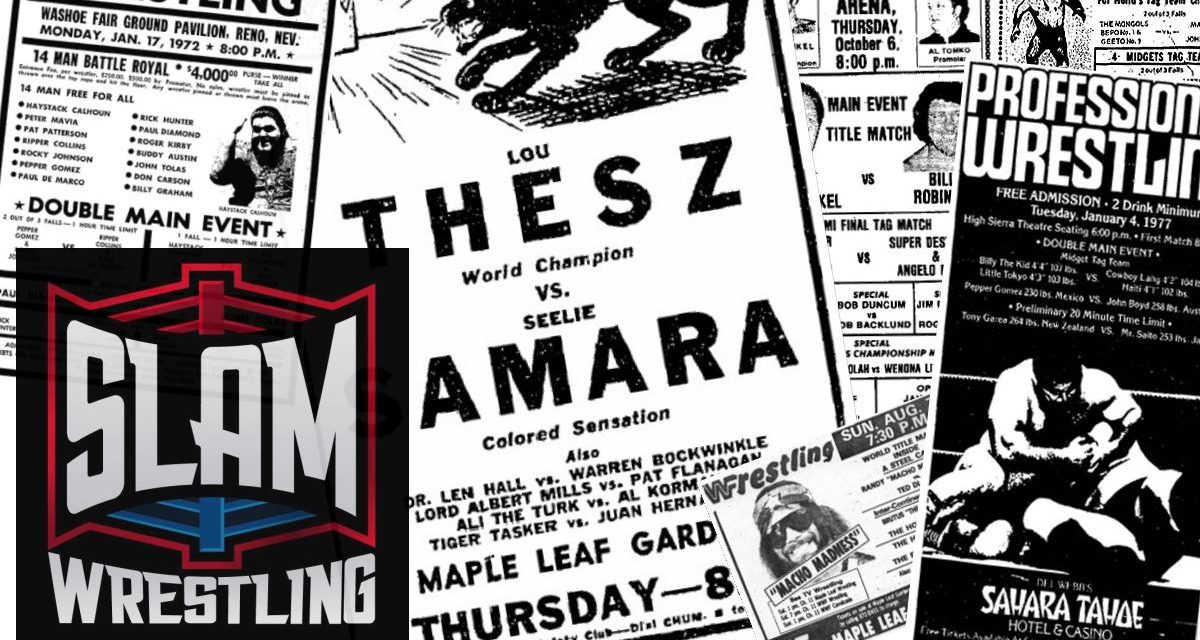As a fan, when you initially catch the wrestling bug, the first thing you do is to gravitate to one or more of your favorite wrestlers. Mine as a child were Leapin’ Larry Chene, Bobo Brazil and Mark Lewin. The more you watched them, the more you wanted to be like them. When I first started attending live shows at Detroit’s famed Cobo Arena in 1964, those men were my favorites. But did I aspire to be a wrestler like one of them? Not a chance.
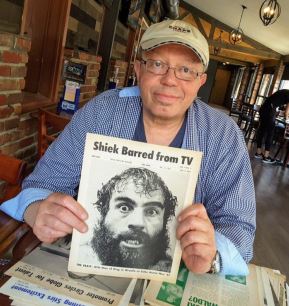
Wilson Lindsey shows off a cover image he did for the Detroit program, Body Press. Photos by Dave Burzynski
My constant companion when attending those memorable events was my Brownie camera, to capture images of my favorites and hopefully have my photo taken with them. Over time, I upgraded my equipment to get better shots and better quality photos that I could trade with fellow ringside fans who were aspiring shutterbugs as well. But we were shooting these images from our seats. Just a few feet away, up at the ring, there was a fellow capturing images that were seen whenever we purchased our Body Press program. His name was Wilson Lindsey, and unlike the wrestlers I came to see, this was the man I aspired to be.
Each show I would see him snapping away, getting the best angles, spectacular up close images that I could only dream of taking. Yes, I admit, I was jealous. I would often sit at my ringside seat and only hope that one day, I could have his job. To be able to capture wrestling’s greatest images and have my photos appear in the Body Press. Yes, I wanted his job. During intermission, I would chat with him about photography, and try to get tips on how to better my craft. He was always personable and nice enough to give his time to this 10-year-old amateur. But still, I was jealous and I wanted his job.
A few years later, I noticed that he was no longer showing up to take photos. No longer was there a photographer to capture the greatest matches happening at the Cobo. Gone, without a trace and no explanation forthcoming. Although it did take me a few more years, my dream did come true. I was the official wrestling photographer at my hometown arena, and lo and behold, my images were appearing in every issue of the Body Press program.
From those years in the early 1970s to the present, I often thought about the man who inspired me to become a photographer. I had no idea whatever happened to him. But thanks to the magic of today’s social media, I saw on one of the wrestling threads the name Wilson Lindsey. I wondered, could it be the same person? Sending a message to him, I was astounded to find out that, yes indeed, it was the very same Wilson Lindsey I admired.
After messaging back and forth, we decided to meet up over lunch, on July 5th at Tavern on the Main in Royal Oak, Mich. Which brings us to my story, after 52 years, I once again got to see my friend who I consider to be the Dean of Detroit wrestling photographers, Mr. Wilson Lindsey.
With so much excitement and so much to talk about, our three-hour conversation included plenty of stories of old-school wrestling, yet our scope of topics discussed saw that our lives had paralleled in so many ways.
Like many of us wrestling fanatics, his interest in professional wrestling was first discovered by watching the weekly TV shows on CKLW Channel 9 out of Windsor, Ont. His interest in photography started at the age of 13, when as a sophomore in high school, his grandfather offered to let him use an old Argus camera that he found while cleaning out an old dresser. Once he began attending live events at the Olympia Stadium, Cobo Arena and most importantly, the live TV tapings, he was instantly hooked on capturing those memories on film. Honing his craft, learning better angles, learning when certain moves were about to occur as be ready to snap when they did, his photos and skills quickly started to take shape.
At one of the TV tapings, he got the opportunity to show some of his images to Detroit promoter Johnny Doyle, in hopes that he would like to purchase them for use in the arena program. He was blown off for his efforts. For weeks on end, he would continually show Doyle his photos but would get nothing more than the usual “good work kid.” About a year later, his persistence finally paid off.
Doyle, along with his partner Jim Barnett, hired Lindsey to be their official ringside photographer. For his efforts, he was given a ticket into the show and was paid a handsome fee of $35 for his work each week. Programs from that era show that his camerawork was second to none in the industry.
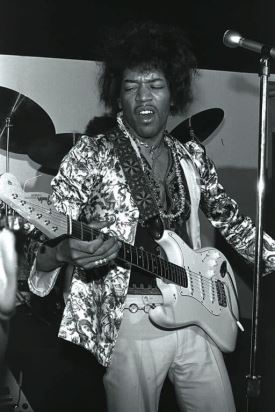
A Wilson Lindsey-shot photo of Jimi Hendrix.
To spur interest in upcoming shows, one of the local dailies, The Detroit Free Press, started using some of Lindsey’s photos in wrestling articles and as publicity shots. Now a student at local Wayne State University, through this connection, Lindsey was offered a freelance position at the newspaper. His assignments, besides wrestling, were mainly music gigs. Being a musician himself, this opportunity was right up his alley. Lindsey got a chance to photograph established acts like The Beatles, Albert King, various Motown acts, and new raw acts such as Jimi Hendrix, Bob Dylan, and so many other future hall of fame stars. Yet, it is one photo assignment that stands out in his memory, that being the Detroit riots of 1967. Dangerous and life threatening, to this day he is happy to have covered the story and survived to tell the tale.
Over time, Lindsey became very good friends with the Doyle family, often visiting their home in the Lafayette Park district of Detroit. They had become like second parents to him, their friendship lasting for years until their passing. He loved them as much as he did wrestling and his passion for photography. But some things were about to change.
One day when visiting Doyle, he was surprised to see other company arrive at the residence — The Sheik and his wife Joyce. He remembers at one point The Sheik sitting at the family piano, tinkering the keys with his nose. Not being a part of the conversation and overhearing very little, it was this day when papers were signed to transfer ownership of Big Time Wrestling from the Doyle/Barnett enterprise to The Sheik Ed Farhat. Part of the sale also stipulated that Lindsey stay on as official photographer and continue to be paid the amount of $35 for shooting each show. All was well and a new era in Detroit’s wrestling history was christened.
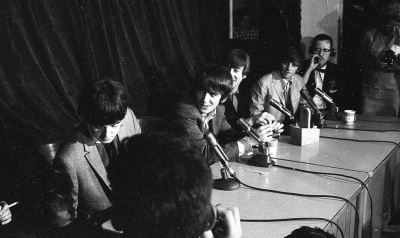
Wilson Lindsey captures a press conference by The Beatles before the band’s gig at Olympia Stadium.
Upgrading his camera equipment to a Nikon F body, Lindsey’s standard Tri-X film images were as impressive as always. Well, at least to some people. A little over a year into his working for the new regime, Lindsey sensed things were beginning to sour. Although he always had a good respectful working relationship with The Sheik, is was his son, Eddie Farhat Jr., who began to criticize his photos and start to rub Lindsey the wrong way. Partially jealous of his musicianship as a gifted guitar player, Farhat Jr. started becoming downright nasty and mean-spirited towards Lindsey. This was the main reason that Lindsey left his post in 1966 as photographer for Big Time Wrestling. Upon hearing this story, I relayed to my long-lost friend that after all these years, Eddie Junior hasn’t changed one bit.
With wrestling out of his system, Lindsey continued to do freelance camera work but started to take his guitar playing to the next level. Excelling in the blues and jazz category, he formed a band called Train. They experienced pretty good success: opening for Grand Funk Railroad and other major headlining acts at the famed Grande Ballroom; playing on the Olympia Stadium Music Fest; doing studio sessions at Berry Gordy’s Motown Studios. Not too shabby a resume.
Expounding on his favorite experiences while working in the wrestling business, Lindsey said having friendships with the likes of Doyle, Ricky Cortez and many others were priceless. He and his camera were always a welcomed dressing room presence, a testament to his likability. The proof is that his many iconic posed shots have lived on.
But there was one wrestler who didn’t like Lindsey.
He has no idea why the tiny terror, Poncho Gonzales, hated him so much. Always finding a reason to hassle him, Lindsey figured it was best to just try to keep his distance. But one day, he and his bandmates happened to be playing a gig at a strip club, I’m sure to keep the young ladies in perfect rhythm. At one point, Lindsey caught sight of a drunk patron, sitting close to the stage, causing a disturbance and trying to paw one of the ladies. It was Poncho Gonzales. Lindsey did his best to duck and hide, but unfortunately, their eyes met and he was busted. During their set break, the boys in the band went outside in the car to take a break and get, ahem, “up” for the next set. Gonzales tracked Lindsey down and began pounding and kicking his vehicle, cursing, threatening violence and wanting a piece of him. The band was scared, not knowing how to defuse the situation and get back to the club safely. Luck was on their side as they were saved by the bouncer who saw the commotion and escorted Gonzales off the premises. Lindsey never saw ol’ Poncho again.
Another misfortune came at the matches, when, during a tag team match, an unruly spectator took out his anger at Fritz Von Erich and flung a metal chair. Unfortunately, the object never reached its intended target but did hit Lindsey squarely on the head, knocking him unconscious. Von Erich was the one who took him out of harm’s way and carried him back to the dressing room. When he came to, Lindsey declined to press charges because he thought it could cost him his job as ringside cameraman.
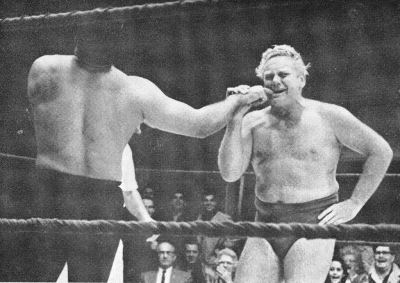
Lou Klein takes a bite out of an opponent.
Lindsey’s favorite all-time photo is that of hero Lou Klein biting his opponent’s fingers during a TV taping. Having not seen the photo prior, Johnny Doyle became very upset when he saw the image appear in the next issue of the Body Press. Over time, all Lindsey’s negatives from those glory years were lost in two separate house floods. Only recently have some of his long-lost photos started appearing in a local Detroit Facebook thread. He has no idea where they came from.
Lindsey informed me that before he left his post with The Sheik, he surrendered a stack of his negatives that were used for years to come in the Body Press program. I told him a friend had purchased them a few years back on eBay, probably by a family member trying to sell off many of The Sheik’s archives. Lindsey was happy to see that those iconic images are once again seeing the light of day.

Dave Burzynski and Wilson Lindsey meet after 52 years.
Looking back at both of our careers, we were surprised to see how similar our lives had been. We both loved wrestling as young kids; we both had, and still have, a passion for photography; we both became ringside photographers and our images filling the pages of the Body Press program; we both became musicians (I’m a drummer) loving the same styles and genres of music; and finally, we share a love of food and a soothing beverage at its side.
What an incredible reunion we had. We have already made plans to do it once again, and it won’t take 52 years this time.
